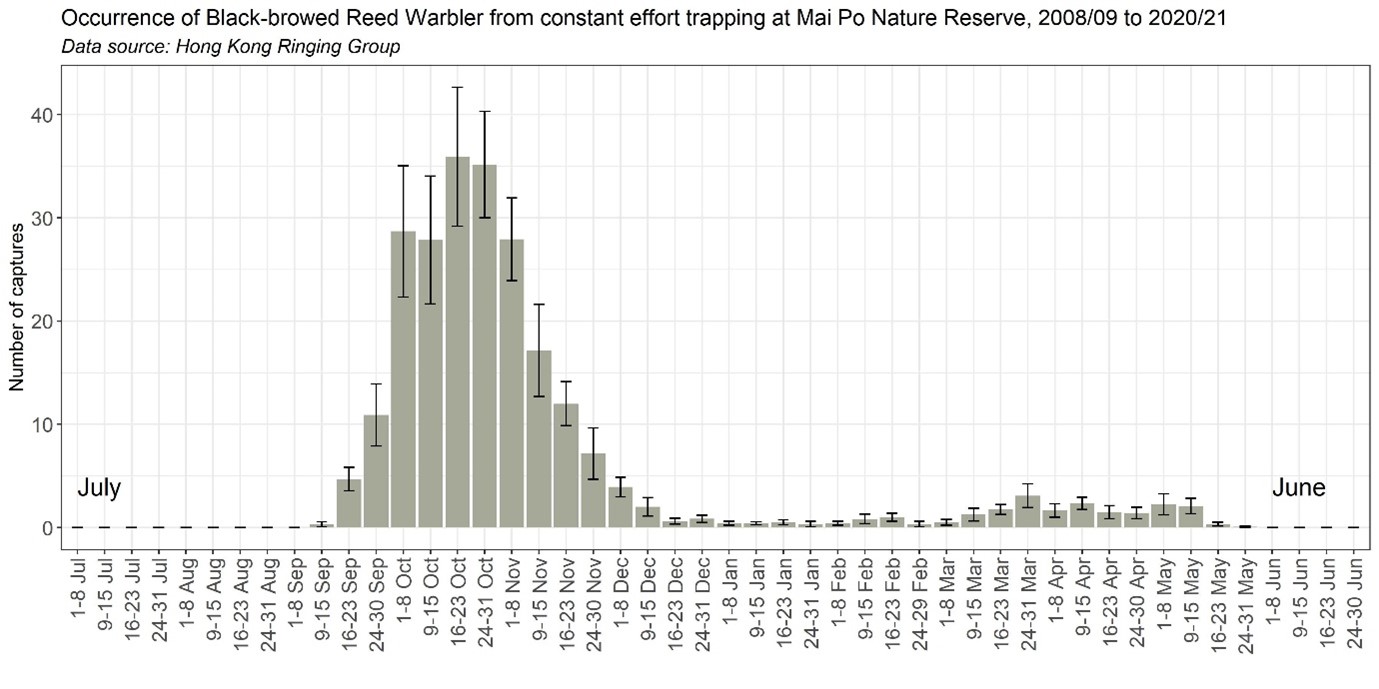Black-browed Reed Warbler Acrocephalus bistrigiceps 黑眉葦鶯
Category I. Passage migrant, common in autumn, uncommon in spring, and scarce to rare in winter. Occurs in wetlands, particularly reed marsh and abandoned wet agriculture.
IDENTIFICATION

Jan. 2023, Paul Leader.
13.5-14 cm. Distinctive head pattern formed by broad buff supercilium (broader behind the eye), bordered above by broad blackish line. The eye stripe is poorly marked and there is usually only a dark spot on the lores. Mid-brown above, more rufous in autumn at which time paler tips to tail feathers may be visible. Off-white below with pale buff flanks. Relatively short-winged and short-tailed (Kennerley and Leader 1992). The most numerous small reed warbler at all times of year.
VOCALISATIONS
The call, which is rather quiet, is a rather soft ‘chik’ or ‘chak’. Also, a rolling ‘trk’ or ‘trrrk’, which comprises two notes uttered very close together and is not generally given by other small Acrocephalus warblers in HK.
The low-intensity song heard here is rather scratchy but interspersed with occasional high-pitched notes reminiscent of Plain Prinia.
DISTRIBUTION & HABITAT PREFERENCE
Black-browed Reed Warbler favours wetland areas, including Phragmites reed beds, fish ponds and abandoned wet agricultural areas; it is in the latter habitat that it is most recorded away from the Deep Bay area. Generally, however, it is rare away from the wetland areas of the New Territories, even on Po Toi. High counts away from the Deep Bay area include 30 at Tung Chung on 22 October 1995 and 40 at Mui Wo on 19 October 1997.
Away from wetland habitat there was a notable series of records during regular surveys at the former airport at Kai Tak during 1974-79, when it was frequently recorded on passage with a maximum of seven on 10 September 1974.
OCCURRENCE
Black-browed Reed Warbler is a passage migrant, common in autumn, uncommon in spring, and is scarce to rare in winter. The earliest record in autumn is ‘several’ at the former airport at Kai Tak on 25 August 1974, one of only four records in that month, three of which are from the same locality. The latest spring record is a bird trapped on 30 May 2016.
The most systematic dataset available for this species comes from the constant-effort trapping programme at Mai Po from the last week of August to the last week of May during winter periods from 2008/09 to 2020/21 (Figure 1). These data indicate that the first birds generally appear in the second week of September, with numbers increasing markedly in the first week of October and peaking in the second half of October. The number trapped then falls to a low in the third week of December, and the species remains rare throughout the winter until the second week of March when the first signs of return movement are evident. Spring passage is extended but at a low level until the last week of May.
Carey et al. (2001) reported that, based on field records submitted, 42% of records to 1998 occurred during the latter half of April and the first half of May, indicating a strength of passage similar to autumn. This was not the case in the trapping data presented by Allcock et al. (2013), nor is it the case with the constant effort trapping data presented here; in both, autumn passage is much stronger. Possible reasons suggested by Allcock et al. (2013) are a change in migration routes, different habitat preference in the two seasons or an observer bias towards spring records because birds are more easily recorded in song. However, it is also possible there has been a decline in a population of birds passing through HK.
The highest count is 120 at Mai Po on 13 October 2001, while the highest spring count is 50 on 25 April 1992; however, the highest spring count this century is only 17 on 2 May 2017.
The highest count from January to mid-February is ten on 13 February 2018. Since 2010 Black-browed Reed Warbler appears to be more common in winter than previously, possibly related to milder winters arising from climate change.
One at Mai Po on 8 October 1950 (Herklots 1953) was the first record for HK. It was subsequently also recorded there in May 1953 (Dove and Goodhart 1955).
BEHAVIOUR, FORAGING & DIET
A shy and skulking species that is much more readily noted via its call. Forages near base of reeds and dense emergent vegetation.
RANGE & SYSTEMATICS
Monotypic. Breeds Sakhalin, Japan and Ussuriland south through northeast China to east China north of the Yangtze River; winters south coastal provinces of China, Indochina and southeast Asia (Dyrcz 2020, Liu and Chen 2020).
CONSERVATION STATUS
IUCN: Least Concern. Population trend stable.
Figure 1.

Allcock, J. A., P. J. Leader, M. R. Leven, D. J. Stanton and K. Leung (2013). Seasonality of Acrocephalus and Locustella warblers in the reedbeds at Mai Po Nature Reserve. Hong Kong Bird Report 2011: 234-252.
Dyrcz, A. (2020). Black-browed Reed Warbler (Acrocephalus bistrigiceps), version 1.0. In Birds of the World (J. del Hoyo, A. Elliott, J. Sargatal, D. A. Christie, and E. de Juana, Editors). Cornell Lab of Ornithology, Ithaca, NY, USA. https://doi.org/10.2173/bow.bbrwar1.01
Dove, R. S. and H. J. Goodhart (1955). Field observations from the Colony of Hong Kong. Ibis 97: 311-340.
Herklots, G. A. C. (1953). Hong Kong Birds. South China Morning Post, Hong Kong.
Kennerley, P. R. and P. J. Leader (1992). The identification, status and distribution of small Acrocephalus warblers in eastern China. Hong Kong Bird Report 1991: 143-187.
Liu, Y. and Y. H. Chen (eds) 2020). The CNG Field Guide to the Birds of China (in Chinese). Hunan Science and Technology Publication House, Changsha.

